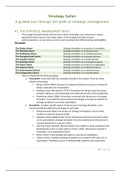Strategy Safari
A guided tour through the wilds of strategic management
H1. THE STRATEGIC MANAGEMENT BEAST
- The strategy-formation beast consists of ten school of thoughts. Each school has a unique
perspective that focuses on one major aspect of the strategy-formation process.
- Each perspective is, in one sense, is narrow and overstated. But still interesting and insightful
The schools
The Design School Strategy formation as a process of conception
The Planning School Strategy formation as a formal process
The Positioning School Strategy formation as an analytical process
The Entrepreneurial School Strategy formation as a visionary process
The Cognitive School Strategy formation as a mental process
The Learning School Strategy formation as an emergent process
The Power School Strategy formation as a process of negotiation
The Cultural School Strategy formation as a collective process
The Environmental School Strategy formation as a reactive process
The Configuration School Strategy formation as a transformation
- The ten schools fall into three groupings:
o Prescriptive: concerned with how strategies should be formulated. There are three
schools in this group:
Design school (1960s): focusses on strategy formation as a process of informal
design, especially one of conception
Planning school (flourished in 1970s): Formalized the design school by seeing
strategy making as a more detached and systematic process of formal planning
Positioning school (1980s): School less concerned with the process of strategy
formation, more with the actual content of strategies. Focusses on selection of
strategic positions in economic marketplace
o Descriptive: considers specific aspects of the process of strategy formation, more
concerned with describing how strategies do get made
Entrepreneurial school: The process of strategy formulation in terms of the
creation of vision by the great leader
Cognitive school: Builds further on the entrepreneurial school, because if vision
can be personalized, strategy formation has to be understood as the process of
concept attainment in a person’s head.
Learning school: Assumes that the world is too complex to allow strategies to be
developed all at once as clear paths of visions, rather, they have to emerge in
small steps, as an organization learns.
Power school: Treats strategy formation as a process of negotiation.
Cultural school: Considers strategy formation to be rooted in the culture of an
organization. Therefore process is fundamentally collective and cooperative.
1|Pagina
, Environmental school: Believed that strategy formation is a reactive process in
which the initiative lies in the external environment
o Configuration: Only contains of one school, could be argued that this groups all the
others together
Configuration school: While seeking to be integrative, the various elements of
the ‘’beast’’ (strategy-making process, content of strategies, organizational
structures and their contexts) are clustered into distinct stages or episodes.
Another side describes the process of transformation, incorporates much of the
prescriptive literature and practice on ‘’strategic change’’
Five P’s for Strategy
- In order to fully understand strategy, five definitions are needed (Mintzberg)
o Strategy is a plan: A direction or course of action into the future, a path to get from here
to there. Mostly concerns looking ahead. It can also be seen as the intended strategy.
Emergent strategy: Where a pattern was realized but not expressly intended
o Strategy is a pattern: Concerns consistency in behavior over time. Mostly concerned
with looking at past behavior. It can also be seen as the realized strategy.
Deliberate strategy: Intentions that are fully realized
o Strategy is a position: This part is about locating of particular products in particular
markets, also known as the outside-in perspective
o Strategy is a perspective: Explains the fundamental way of doing or thinking of an
organization, also known as the inside-out perspective
o Strategy is a ploy: A specific maneuver intended to outwit an opponent or competitor.
- No strategies are purely deliberate (no learning) or purely emergent (no control), every strategy
has a little bit of both.
- Real-world strategies need to mix both: to exercise control while fostering learning. Thus
strategies have to form, as well as be formulated.
o Umbrella strategy: The broad outlines are deliberate, while the details are allowed to
emerge en route
- Changing position within perspective may be easy; changing perspective, even while trying to
maintain position is not
- The relationships between the definitions and the schools are varied, although some of the
schools have preferences
Strategies for better and for worse
For every advantage associated with strategy, there is an associated drawback or disadvantage
1. Strategy sets direction
o Disadvantage: strategic direction can also serve as a set of blinders to hide potential
dangers (setting out a predetermined course in unknown waters is perfect way to sail
into an iceberg)
2. Strategy focusses effort
o Disadvantage: Groupthink arises when effort is too carefully focused. There may be no
peripheral vision, to open other possibilities
3. Strategy defines the organization
o Disadvantage: To define an organization too sharply may also mean define it too simply,
sometimes even to the point of stereotyping
2|Pagina
, 4. Strategy provides consistency
o Disadvantages: Since creativity thrives on inconsistency, consistency isn’t always good. It
has to be realized that every strategy is not reality themselves, only a representation of
reality of the minds of people. This means that every strategy can have a
misrepresenting or distorting effect.
- The major role of strategy in organizations is: the resolving of big issues so that people can get
on with the little details like targeting and serving customers instead of debating which markets
are best.
- When situations change, all that is constructive and effective about an established strategy
becomes a liability. That is why strategy is always so focused on change.
- Strategy, as a mental set, can blind the organization to its own outdatedness, it keeps the
organization going in a straight line, but hardly encourage peripheral vision.
- Strategies (and the strategic management process) can be vital to organizations by their absence
as well as their presence
H2. THE DESIGN SCHOOL – strategy formation as a process of
conception
- The design school proposes a model of strategy making that seeks to attain a match, or fit,
between internal capabilities and external possibilities
- Establishing fit is the motto of the design school
Origins of the design school
- The origins of the design school can be traced back to two influential books written at University
of California (Berkeley) and at M.I.T.. By Philip Selznick and Alfred D. Chandler’s
- Selznick: introduced ‘’distinctive competence’’, this discussed that the organization’s ‘’internal
state’’ needs to be brought together with its ‘’external expectations’’. Also he argued for building
policy into the organization’s social structure, which later got called implementation
- Chandler: established the school’s notion of business strategy and its relationship to structure.
- The General Management group at the Harvard Business School brought a book that became the
dominant voice for this school of thought
The basic design school model
- The model of the design school places
primary emphasis on the appraisals of the
external and internal situations.
- The emphasis on the external situations
uncovers threats and opportunities in the
environment
- The emphasis on the internal situtaions
reveals strengths and weaknesses of the
organizaiton.
- The model also points out two other factors
believed imporant in strategy making
o Managerial values: the beliefs and
preferences of thos who formally
lead the organization
3|Pagina
, o Social responsibilities: the ethics of the society in which the organization functions, at
least as perceived by mangers
- There are various environmental variablities to take into account when assesing the
environment, such as: societal, governmental, economic, competitive, supplier, and market
changes.
- Once alternative strategies have been determined, the next step in the model is to evaluate
them and chooses the best one. Rumelt from the Harvard General Management group has
provided the best framework for making this evaluation, based on a few tests:
o Consistency: the strategy must not present mutually inconsistent goals and policies
o Consonance: the strategy must represent an adaptive response to the external
environment and to the critical changes occurring within it
o Advantage: the strategy must provide for the creation and/or maintenance of a
competitive advantage in the selected area of activity
o Feasibility: the strategy must neither overtax available resources nor create unsolvable
subproblems
- Once a strategy has been agreed upon, it is then implemented. In the model, implementation is
flaring out again, because after the appraisals have been completed to narrow down to
convergent choice, the process diverges again to ensure implementation across entire
organization.
- The design school provided a basis for the developments of other schools
Premises of the design school
1. Strategy formation should be a deliberate process of conscious thought: effective strategies
derive from a tightly controlled process of human thinking. Strategy making in this sense in an
acquired, not a natural skill, or intuitive one, it must be learned formally
2. Responsibility for that control and consciousness must rest with the CEO: there is only one
strategist, that is the manager who sits at the apex of the organizational pyramid, the CEO. This
premises not only relegates other members of the organization to subordinate roles in strategy
formation, but also precludes external actors from the process altogether.
3. The model of strategy formation must be kept simple and informal: the elaboration and
formalization will sap the model of its essence. This premises goes with the second one, one way
to ensure that strategy is controlled in one mind is to keep it simple.
4. Strategies should be one of a kind: the best ones result from a process of individualized design:
strategies have to be tailored to the individual case. The design school says little about the
content of strategies themselves, but instead concentrates on the process by which they should
be developed. That process should be a creative act to build on distinctive competence
5. The design process is complete when strategies appear fully formulated as perspective:
Strategy is viewed as the grand conception, the ultimate choice. That strategy appears as a
perspective, at some point in time, fully formulated and ready to be implemented. When a
strategy is ready to be implemented, no emergent formulation will be happening
6. The strategies should be explicit, so they have to be kept simple: they have to be kept simple so
that strategies are explicit for those who make them and, if at all possible, articulated so that
others in the organization can understand them
7. Finally, only after these unique, full-blown, explicit, and simple strategies are fully formulated
can they then be implemented: the design school clearly separates thinking from acting.
Therefore, structure must follow strategy. It is assumed that each time a new strategy is
formulated, the state of structure and everything else in the organization must be reconsidered
4|Pagina






